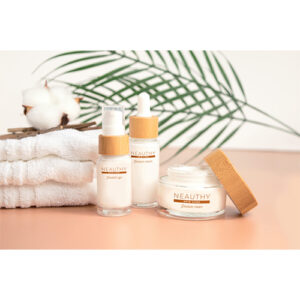Cosmetic-grade emollients are widely used in skincare and hair care products due to their moisturizing and conditioning properties.
Here are some common uses of cosmetic-grade emollients:
Moisturization: Emollients help to hydrate and moisturize the skin and hair by forming a protective barrier that reduces water loss. They help to restore and maintain the skin’s natural moisture balance, leaving it soft, smooth, and supple.
Skin Conditioning: Emollients improve the texture and feel of skincare products by imparting a smooth and silky sensation to the skin. They help to soften rough or dry skin, making it more pliable and comfortable.
Hair Conditioning: Emollients are used in hair care products like shampoos, conditioners, and styling products to enhance hair softness, manageability, and shine. They smooth the hair cuticle, reduce frizz, and prevent moisture loss, resulting in healthier-looking and more manageable hair.
Barrier Function: Emollients act as a protective barrier on the skin, shielding it from external environmental factors such as harsh weather, pollutants, and irritants. They help to maintain the skin’s natural defense mechanisms and prevent transepidermal water loss (TEWL).
Lubrication: Emollients provide lubrication to skincare and hair care products, making them easier to apply and spread evenly on the skin or hair. This property facilitates the smooth application of creams, lotions, and serums, ensuring even coverage and absorption.
Sensory Enhancement: Cosmetic-grade emollients contribute to the sensory experience of using skincare and hair care products. They improve the glide, spreadability, and overall aesthetics of formulations, giving a luxurious feel and enhancing the user experience.
Solvent and Carrier: Emollients can serve as solvents and carriers for other active ingredients in cosmetic formulations. They help dissolve or disperse various ingredients, ensuring their proper delivery and efficacy.
Massage and Spa Products: Emollients are commonly used in massage oils, body butters, and spa products due to their smooth and gliding properties. They facilitate massage techniques, leaving the skin feeling nourished and pampered.
Lip Care: Emollients are essential in lip balms, lipsticks, and lip glosses to provide hydration, softness, and protection to the delicate lip area. They help prevent chapping and dryness, keeping the lips smooth and moisturized.
Sunscreens: Emollients are often included in sunscreen formulations to provide a smooth and moisturizing base. They improve the spreadability of the product, enhance its texture, and contribute to the overall skin feel.
It’s important to note that different emollients have varying properties and may be suitable for specific applications or skin/hair types. China Cosmetic Grade supplier The specific emollients used in a product formulation depend on factors such as desired texture, targeted benefits, compatibility with other ingredients, and regulatory considerations.
How are cosmetic-grade preservatives utilized in cosmetic formulations?
Cosmetic-grade preservatives play a crucial role in cosmetic formulations by preventing the growth of microorganisms and extending the shelf life of the products.
Here’s how cosmetic-grade preservatives are utilized:
Microbial Protection: Preservatives are added to cosmetic formulations to inhibit the growth of bacteria, fungi, yeast, and other microorganisms that can cause product spoilage, contamination, and potentially harm the user. They help maintain the integrity and safety of the products.
Broad-Spectrum Activity: Cosmetic-grade preservatives are chosen for their broad-spectrum antimicrobial properties, meaning they are effective against a wide range of microorganisms. This ensures comprehensive protection against various types of bacteria and fungi that may be present in the formulation or introduced during product use.
Product Stability: Preservatives contribute to the stability of cosmetic formulations by preventing microbial growth, which can lead to changes in texture, color, odor, and overall product quality. They help maintain the desired characteristics and appearance of the products over their intended shelf life.
Water-Based Formulations: Preservatives are particularly important in water-based cosmetic products such as creams, lotions, serums, and liquid foundations. These formulations provide a favorable environment for microbial growth due to the presence of water, which is an essential factor for microbial proliferation. Preservatives ensure the safety and stability of these products.
Multi-Ingredient Formulations: Preservatives are essential in cosmetic formulations that contain multiple ingredients, especially those with natural or organic components. These formulations may be more vulnerable to microbial contamination, and preservatives help protect against potential spoilage by microorganisms.
Compliance with Regulations: The use of cosmetic-grade preservatives is necessary to comply with regulatory requirements and guidelines for cosmetic products. Regulatory agencies, such as the FDA, set specific standards and limits for preservatives to ensure product safety and consumer protection.
Preservative Systems: In some cases, a combination of preservatives is used to create a preservative system in cosmetic formulations. This approach enhances the efficacy and stability of the preservatives, as different preservatives may have varying effectiveness against different microorganisms. Preservative systems provide a synergistic effect, ensuring comprehensive protection.
Challenge Testing: Cosmetic formulations containing preservatives typically undergo challenge testing to evaluate their microbial resistance and effectiveness. Challenge tests simulate real-life conditions to assess the ability of the preservatives to inhibit microbial growth and prevent contamination.
It’s important to note that the selection and use of cosmetic-grade preservatives should follow guidelines and regulations specific to each country or region. Manufacturers carefully consider factors such as the product’s intended use, compatibility with other ingredients, potential interactions, and any specific considerations for sensitive or allergic individuals. The concentration of preservatives used is determined based on their recommended usage levels and efficacy against target microorganisms while ensuring product safety.
